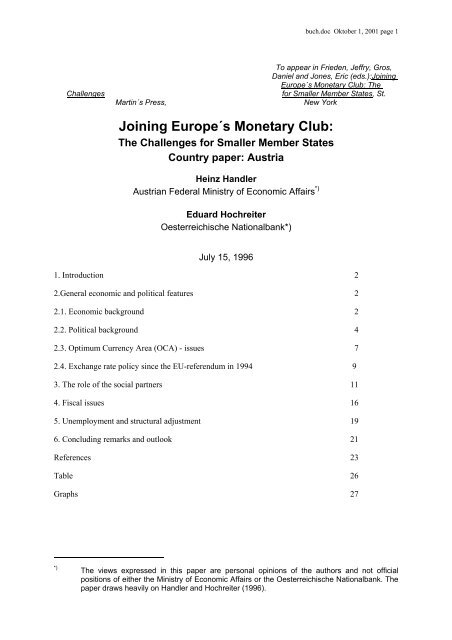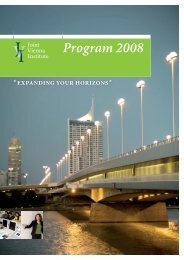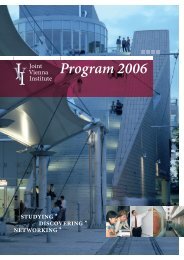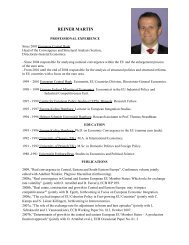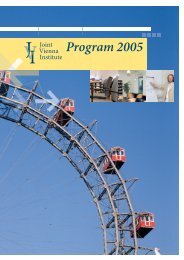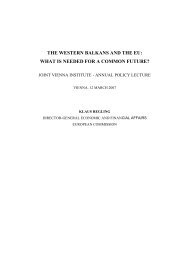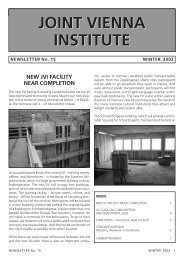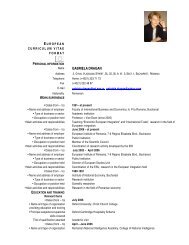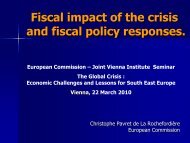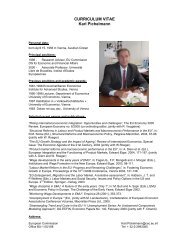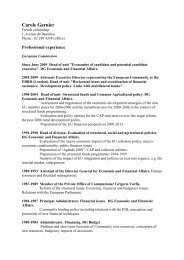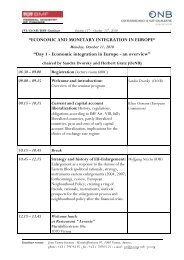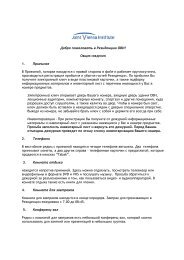Joining Europe´s Monetary Club - Joint Vienna Institute
Joining Europe´s Monetary Club - Joint Vienna Institute
Joining Europe´s Monetary Club - Joint Vienna Institute
Create successful ePaper yourself
Turn your PDF publications into a flip-book with our unique Google optimized e-Paper software.
uch.doc Oktober 1, 2001 page 1<br />
To appear in Frieden, Jeffry, Gros,<br />
Daniel and Jones, Eric (eds.):<strong>Joining</strong><br />
<strong>Europe´s</strong> <strong>Monetary</strong> <strong>Club</strong>: The<br />
Challenges for Smaller Member States, St.<br />
Martin´s Press, New York<br />
<strong>Joining</strong> <strong>Europe´s</strong> <strong>Monetary</strong> <strong>Club</strong>:<br />
The Challenges for Smaller Member States<br />
Country paper: Austria<br />
Heinz Handler<br />
Austrian Federal Ministry of Economic Affairs *)<br />
Eduard Hochreiter<br />
Oesterreichische Nationalbank*)<br />
July 15, 1996<br />
1. Introduction 2<br />
2.General economic and political features 2<br />
2.1. Economic background 2<br />
2.2. Political background 4<br />
2.3. Optimum Currency Area (OCA) - issues 7<br />
2.4. Exchange rate policy since the EU-referendum in 1994 9<br />
3. The role of the social partners 11<br />
4. Fiscal issues 16<br />
5. Unemployment and structural adjustment 19<br />
6. Concluding remarks and outlook 21<br />
References 23<br />
Table 26<br />
Graphs 27<br />
*) The views expressed in this paper are personal opinions of the authors and not official<br />
positions of either the Ministry of Economic Affairs or the Oesterreichische Nationalbank. The<br />
paper draws heavily on Handler and Hochreiter (1996).
1. Introduction<br />
buch.doc Oktober 1, 2001 page 2<br />
Following membership in the European Union (EU), the next big challenge for<br />
Austrian policy makers and the public alike is to prepare for full participation in<br />
Economic and <strong>Monetary</strong> Union (EMU). On an economic-political level, Austria has<br />
always been integration-minded and trade relations have been centered on the EU.<br />
In the monetary field, Austria has long been integrated - via a quasi monetary union<br />
with Germany - into the likely core of EMU. Therefore, support to join EMU has been<br />
widespread and solid. In contrast to other (small) countries, the collective bargaining<br />
process inbedded in the Austrian system of social partnership has not only survived<br />
up to now but, so far, has nourished hope that it can adjust to the new challenges<br />
ahead. We believe that Austria´s unique framework of economic decision making<br />
may offer the EU a good way to deal with economic problems which may be<br />
worthwhile to be explored further.<br />
Section 2 assesses the economic and political developments in Austria prior to the<br />
country´s accession to the EU on January 1, 1995 and in the following 18 months.<br />
One focus explicitly relates to the issue of whether Austria forms an optimum<br />
currency area with Germany or, more broadly, with the European hard core<br />
countries. Section 3 discusses the unique role of the social partners in Austria.<br />
Section 4 covers the thorny fiscal issues. The burning areas of unemployment and<br />
structural adjustment are discussed in section 5. The final section offers some<br />
concluding remarks and gives an outlook.<br />
2. General economic and political features<br />
2.1. Economic background<br />
When Austria applied for EU membership in mid-1989, she was on a strong,<br />
Maastricht-convergent real growth path of around 4 per cent p.a. (and cumulatively of<br />
some 15 per cent in the period 1988-1991) without signs of bottlenecks or other<br />
strains. This was made possible by<br />
(a) a well-balanced tax reform (effective January 1989) entailing a substantial<br />
lowering of personal and corporate taxation,<br />
(b) the liberalization of foreign transactions in a number of steps (completed in<br />
November 1991), while the rather slow pace of deregulation of the domestic<br />
economy apparently did not hold the economy back that much,<br />
(c) structural adjustment in the nationalized industries (redimensioning, spin-off and<br />
closing of plants, resulting in a reduction of the workforce by one-third or 33,000<br />
employees),<br />
(d) moderate wage settlements with high productivity gains in industry,<br />
(e) credible medium-term fiscal consolidation measures, also designed to raise the<br />
incentives to work and to improve the supply side of the economy, and<br />
(f) a favourable international economic environment.
uch.doc Oktober 1, 2001 page 3<br />
In short, economic policy attempted to raise potential growth and thereby lift sustainable<br />
actual growth 1 ). Moreover, Austria substantially benefited from the opening<br />
of the East 2 ) with cumulative net exports of roughly 65 billion ATS (1990-1994) 3 ),<br />
which, despite sizeable structural adjustments, is estimated to have increased (net)<br />
overall employment by 10,000 to 15,000 persons 4 ).<br />
In contrast to most other European countries, Austria’s recession in 1993 was rather<br />
shallow. Its mildness can be explained by the introduction of fiscal support measures<br />
by the government (including the second phase of a tax reform), by the working of<br />
automatic stabilizers and by buoyant demand from reunified Germany. The<br />
downswing did, however, highlight and accentuate the weak structural position of the<br />
budget, which deteriorated sharply 5 ). For the first time, Austria was no longer able, as<br />
of 1993, to fulfill the fiscal convergence criteria, as contained in Protocol No.5 to the<br />
Maastricht Treaty. By 1994 it had also become clear that the Austrian fiscal position<br />
was rapidly becoming unsustainable. Both the deficit and the public debt soared and<br />
made retrenchment measures urgent regardless of Austria´s desire to be part of the<br />
core of EMU. Yet, it took until 1996 that decisive fiscal consolidation measures could<br />
be implemented.<br />
Austria’s inflation performance in the past 2 decades by and large has mirrored that<br />
of Germany - an outcome of the fixed peg. However, the rate of consumer price<br />
inflation was on average (with the notable exception of 1991 - 1993 when Germany<br />
was coping with the unification shock) about 1 percentage point higher than in<br />
Germany, reflecting competition deficiencies in the sheltered sector 6 ). Moreover,<br />
inflation has only with substantial delay responded to increasing competition in the<br />
wake of European Economic Area (EEA) and EU memberships.<br />
The opening of the East, Austria’s membership in the EEA as of 1993 and in the<br />
European Union as of 1995, significant depreciations of foreign currencies important<br />
to Austria after the speculative attacks of 1992, 1993 and 1995, as well as the efforts<br />
to consolidate the budget have exposed structural weaknesses of the Austrian<br />
economy in certain important and highly visible industries, e.g., tourism (foreign<br />
tourism accounts for about 8 % of GDP), the paper industry (competing, i.a., with<br />
Finland and Sweden) and textile and clothing (outsourcing of low value-added<br />
production to Eastern Europe). Judged from previous performance, Austrian industry<br />
all in all appears to be flexible enough to cope with such shocks. Such flexibility will<br />
decisive for smooth economic adjustment in Stage 3 of EMU.<br />
1<br />
) This is in sharp contrast to the 1970s when actual growth was lifted by raising public and<br />
private demand through expansionary policies. They had to be aborted in the late 1970s when<br />
the current account deficit of the balance of payments became unsustainable.<br />
2<br />
) See, e.g., Schebesch and Wörgötter (1995).<br />
3<br />
) Cumulative surpluses 1985-1989: about 10 bn ATS; Eastern Europe including FSU and<br />
Yugoslavia.<br />
4<br />
) Kramer (1993). He calculates a gain of 60,000 to 65,000 and at the same time a loss of<br />
50,000 jobs in 3 to 5 years starting in 1992.<br />
5<br />
) See Genser and Holzmann (1995). About half of the increase of the (federal) budget deficit in<br />
1993 and 1994 can be attributed to structural factors.<br />
6<br />
) Hochreiter and Winckler (1995a), 172.
2.2. Political background<br />
buch.doc Oktober 1, 2001 page 4<br />
Austria has always been integration-minded and thus has over time furthered<br />
European integration. As a small country at the edge of the Western industrialized<br />
world, Austria in 1955 chose to remain neutral between the Eastern and Western<br />
blocs and fulfilled some bridging functions 7 ). Austria, in contrast to Switzerland, has<br />
seen her position in world politics as an active partner, becoming a member of UN<br />
organizations, including the Bretton Woods institutions, at a rather early stage.<br />
Bound by the State Treaty of 1955, Austria was not in a position to join the European<br />
Economic Community (EEC) from its beginning in 1958. In particular, Austria was<br />
prohibited from entering any formal integration arrangement with Germany, and<br />
therefore opted for the foundation of the European Free Trade Association (EFTA).<br />
This course was favoured by the Socialist Party (SPÖ) which, at the time, was<br />
viewing the European Communities as a bloc of conservative governments. Attempts<br />
in the 1960s to reinterpret the State Treaty so as to allow Austrian membership in the<br />
EEC were frustrated by the Soviet Union. It was not until 1972 that Austria (together<br />
with other EFTA countries) was able to sign an association agreement with the EEC,<br />
providing for the gradual abolition of tariffs on trade and for rules to secure fair<br />
competition between the trading partners. Although Austria’s membership in EFTA induced<br />
substantial trade diversion at the expense of trade with EEC countries, the<br />
latter by far remained the most important trading partners of Austria. It was always<br />
clear that Austria, from an economic point of view, would prefer EEC to EFTA<br />
membership. At the same time, the increasing EEC links with Western political and<br />
defence organizations made it ever more unlikely for Austria to join the Common<br />
Market.<br />
A fundamental change in attitude both in Austria and in the other EFTA countries<br />
became visible in the mid-1980s when the European Commission published the<br />
White Paper on the completion of the Single Market. For Austria in particular, the<br />
fortunate events in Central and Eastern Europe since 1989 opened the political<br />
window to negotiate EC membership. As early as 1987, the federal government -<br />
newly formed as a grand coalition between the renamed Social Democrats (SPÖ)<br />
and the conservative People’s Party (ÖVP) - had started to evaluate the legal and<br />
economic adjustment needs vis-à-vis the EC. A „Working Group on European<br />
Integration“ was set up under the auspices of the Federal Ministry of Foreign Affairs,<br />
comprising experts from federal and regional authorities as well as from the social<br />
partners. The early involvement of the social partners, in particular the Chambers of<br />
Labour, Commerce and Agriculture, in this process was one of the major<br />
characteristics in the preparation of future EU membership. This attitude of<br />
cooperation turned out instrumental in the parliamentary decision of June 1989 to<br />
support the government’s move to apply for EU membership, which was carried out a<br />
month later. The broad consensus of the Austrian population in favour of joining the<br />
EU was strengthened by myriads of discussions organized within the<br />
7 ) For a discussion of Austria´s bridging function, see Hochreiter (1994).
uch.doc Oktober 1, 2001 page 5<br />
memberships of the individual social partner groupings 8 ). The consensus rested on<br />
economic arguments, but was augmented by political considerations (participation in<br />
the EU decision-making process) and by security reasons provoked by the<br />
breakdown of the former East bloc.<br />
With some delay the antagonists were organizing themselves and formulating their<br />
arguments around the topics of neutrality, loss of Austrian sovereignty, wateringdown<br />
of social, health and environmental standards, overboarding transit traffic, and<br />
the evils of Euro-bureaucracy. The opponents’ flag was carried by the right-wing<br />
Freedom Party and the Greens. The Freedom Party, initially in favour of EU<br />
membership, had turned its head under the populist leadership of Jörg Haider who<br />
emphasized the nationalistic party wing at the expense of the liberal wing. The latter<br />
split off in 1994 by forming the new Liberal Forum party which has strongly advocated<br />
EU membership. On a European level, the Maastricht referenda in Denmark (June<br />
1992 and May 1993) and France (September 1992), as well as the rejection by the<br />
Swiss population of EEA membership (December 1992) fuelled the opposition<br />
against further integration steps. Undecisive EU policies in the wake of dissolving<br />
former Yugoslavia and the recession in Europe were adding to the mounting critique.<br />
According to Austrian opinion polls, the cons against EU membership were balancing<br />
the pros by the end of 1993 (Plasser and Ulram, 1994).<br />
In early 1994, when the accession negotiations with the European Commission were<br />
communicated over the media, the pros were gaining again. Although the opposition<br />
against EU membership stiffened as the date of the referendum was approaching,<br />
the EU referendum brought a decisive majority of 66.4 per cent in favour of EU<br />
membership, the highest affirmative vote among all the (potential) accession<br />
countries. Although opinion polls were pointing at a positive outturn, the large<br />
majority was by no means clear given the rising appeal to the general public of<br />
demagogic arguments against membership, particularly from Freedom Party<br />
representatives, as the referendum was coming due. Opinion polls in Austria<br />
revealed that 32 per cent of assenting voters took their decision during the „last few<br />
weeks before“ the referendum while only 22 per cent of dissenting voters decided<br />
that late. According to exit polls, all major population groups had on average voted<br />
pro EU. The younger population (less than 30 years of age) was much more sceptical<br />
(55 per cent pros) than the generation of 60 years and more (70 per cent pros).<br />
People with higher education were more affirmative than those with basic education<br />
only. Uncertainies about the consequences of EU membership were particularly<br />
widespread among farmers who voted 70:30 against accession. Sympathizers with<br />
political parties were quite diverse in their voting behaviour: 75 per cent of Liberal<br />
Forum followers voted pro. SPÖ voters (73 per cent pros) and ÖVP voters (66 per<br />
cent pros) also supported membership. In contrast, Freedom Party and Green Party<br />
followers (41 and 38 per cent pros, respectively) were dampening the overall result<br />
(Plasser and Ulram 1994).<br />
8 ) Based on poll data provided by Plasser and Ulram (1994), Plavsak (1995) argues that, in<br />
contrast to the "national elites", the population at large was left uninformed and thus had no<br />
opportunity to participate in the decision-making process on equal grounds. This is true only to<br />
the extent that also the "elites" were seemingly in trouble to gather relevant information. Its<br />
piecemeal dissemination via the social partner organizations and the media may at times have<br />
created disturbances and uncertainties, but cannot be interpreted as deliberately withholding<br />
information.
uch.doc Oktober 1, 2001 page 6<br />
In the parliamentary elections of October 1994, the grand coalition of SPÖ and ÖVP<br />
was thought to gain from the euphoria in the wake of the EU referendum. However,<br />
the election campaign of the two parties failed and they lost heavily, particularly to the<br />
Freedom Party of Jörg Haider. Through his radically populistic approach, Haider has<br />
been able over the years to appeal to the discontented followers of other political<br />
parties. Although SPÖ and ÖVP were able to form a new government, quarrels<br />
concerning budget consolidation (required regardless of the provisions contained in<br />
the Maastricht Treaty) dominated over joint efforts to help businesses and consumers<br />
to smoothly adjust to the new situation. In the media, most of the blame for the<br />
projected budget deficit was put on the EU. During the election campaign, SPÖ and<br />
ÖVP had promised to refrain from tax increases and to reduce the budget deficit by<br />
cutting expenditure only. However, as the social partners had not been consulted for<br />
the elaboration of the consolidation programme, they felt free to oppose the<br />
Government’s plans of cutting social transfers and investment support. In the early<br />
months of 1995, public disappointment rose over the disputes within the Government<br />
and the lack of immediately visible economic gains from EU membership. If opinion<br />
polls can be trusted, a new referendum in mid-1995 would have turned down EU<br />
membership 9 ). This corresponds with the conclusions in Plavsak (1995), who views<br />
the outcome of the referendum as a conditional public consensus reached at a<br />
specific point in time and sensible to various changing factors.<br />
Such disappointment is to a large extent related to overdrawn short-term economic<br />
expectations and to the political polarisation associated with the referendum and the<br />
parliamentary elections. As seen from hindsight, politicians were at times not careful<br />
enough in their wording when explaining the long-term advantages of EU<br />
membership (as were opposition parties in demonstrating the evils). In addition,<br />
economists, in general supporting membership, were not able to properly get across<br />
to the public the caveats to be associated with the results of their research. Above all,<br />
the federalism provided for in the Austrian Constitution has led to an ongoing struggle<br />
over the financial consequences of EU membership.<br />
Disenchantment with the EU continued to be high throughout 1996 as the results of<br />
the elections to the European Parliament in October 1996 clearly showed .....<br />
TO BE COMPLETED AFTER THE ELECTION TO THE EUROPEAN<br />
PARLIAMENT TO BE HELD IN AUSTRIA ON October 13, 1996 !!!!!!!!!!!!!!!!!<br />
9 ) According to Fessel+GFK (1995), poll results of May 1995 reveal that in a new referendum<br />
some 50 per cent of voters would have declined EU membership while only 42 per cent would<br />
have supported it.
2.3. Optimum Currency Area (OCA) - issues<br />
buch.doc Oktober 1, 2001 page 7<br />
Austria, unlike other countries, has favoured a pegging strategy ever since the<br />
unification of the exchange rate in 1953. Under the Bretton Woods system, the ATS<br />
was pegged to the USD with an unchanged fixed parity. In August 1971, when the<br />
US closed the gold window, Austria opted for a trade-weighted basket peg (the socalled<br />
„indicator“ peg 10 ) and thereby pioneered the nominal effective exchange rate<br />
concept. Over time, more and more currencies were removed from the basket,<br />
because they were either devalued against the DEM or too volatile (SFR). Since late<br />
1981 the ATS has remained practically fixed vis-a-vis the DEM.<br />
Considerations of OCAs concern the sustainability of a fixed peg, or, indeed, the<br />
viability of a monetary union. It is the ability of a country (region) to deal with<br />
asymmetric shocks 11 ). As long as shocks within a monetary union are symmetric,<br />
there is no need to change relative prices among regions and hence there is no need<br />
to change the exchange rate between regions. If, however, asymmetric shocks<br />
dominate, labour and capital have to be mobile in order to maintain the exchange<br />
rate. If factors of production are immobile, wages and prices have to be flexible<br />
enough to allow the necessary adjustment of relative prices. In fact, the evolution of<br />
Austria´s exchange rate policy and its growing support by the social partners over<br />
time reflected the conviction by the policy makers that the domestic economy (e.g.,<br />
wages) would indeed be flexible and productive enough to adjust and hence, that<br />
Austria could forego the exchange rate as an adjustment instrument.<br />
There are, however, a few exceptions. In May 1974, when inflation surged worldwide,<br />
Austrian policy makers urgently sought measures to bring inflation down. Being<br />
aware of the fast pass-through and the close link between domestic inflation and<br />
wages because of the social partnership system, the exchange rate was explicitly<br />
employed as an instrument to bring inflation down, i.e., the exchange rate was<br />
revalued both in nominal (against the DEM) and in real terms. Note also that this<br />
occurred in a situation of quite unfavourable fundamentals with respect to Germany.<br />
Policy makers were aware of the negative impact effects of this policy on profits, but<br />
at the same time they were confident that the profit squeeze in the exposed sector<br />
due to the real revaluation was temporary. Yet, overall domestic adjustment during<br />
the 1970s turned out to be insufficient, resulting in an unsustainable current account<br />
deficit of about 4 ½ % of GDP in 1977. In its wake, policy (especially fiscal and wage<br />
policies) was tightened and the ATS slightly devalued against the DEM. These<br />
measures were successful and, by the time of the second oil crisis, Austrian policy<br />
makers were confident enough that they could yet again revalue against the DEM to<br />
rein in inflation. This revaluation happened in September 1979 when the ATS was<br />
revalued against the DEM by 1 ½ % followed by a gradual appreciation between<br />
September 1979 and late 1981 amounting to some 4 ½ %. Since then the ATS/DEM<br />
exchange rate has been practically fixed.<br />
10<br />
) The indicator basket initially contained 6 currencies representing the currencies of 9 countries;<br />
the DEM, SFR, HFL (also representing the BFR/LFR), SKR (also representing the DKR), Lit<br />
and GBS.<br />
11<br />
) A useful discussion regarding asymmetric shocks in an EU-context is contained in Pauer<br />
(1996)
uch.doc Oktober 1, 2001 page 8<br />
By that time policy makers and the social partners more clearly saw the requirements<br />
and the depth of measures necessary to make a fixed peg sustainable, and, for the<br />
first time, arguments stressing the need for credibility of policy, in particular exchange<br />
rate policy, surfaced. These statements reflect the view that for a small open<br />
economy a simple, straightforward and transparent rule that is understood by the<br />
public would be the best way to earn credibility fast, and to achieve and maintain<br />
price stability 12 ). The strategy has been underpinned by a credible commitment by<br />
the Oesterreichische Nationalbank to maintain it in difficult times and by a broad<br />
consensus by society (both employers and employees) that price stability is a<br />
necessary condition for growth and employment in the medium term. Moreover, it<br />
was understood that the sustainability of the peg (with low economic cost) hinges on<br />
fiscal soundness and wage moderation. As a consequence, Austria could also cope<br />
with sizeable asymmetric shocks.<br />
Hochreiter and Winckler (1995) deal empirically with the issue of shocks for Austria<br />
and find that when the current exchange rate policy was shaped in the early 1970s,<br />
asymmetric shocks with regard to Germany dominated. The authors identify the<br />
following asymmetric shocks relative to Germany between 1975 and 1985 using<br />
cross-section analysis over 20 industrial branches in Austria and Germany:<br />
1) 1975: Wage shock (unit labour costs: predominantly asymmetric, permanent,<br />
negative supply and positive demand shock)<br />
2) 1978: Restrictive policy measures in Austria to overcome the current account<br />
crisis (predominantly asymmetric, temporary, negative demand shock)<br />
3) 1980-82: Fiscal shock (slightly asymmetric, temporary, positive demand shock)<br />
4) 1980-81: Wage shock (unit labour costs: asymmetric, permanent, positive supply<br />
and negative demand shock)<br />
5) 1982-83: Debt crisis (predominantly asymmetric, permanent, negative demand<br />
shock)<br />
6) 1983-85: Crisis of nationalized industries (asymmetric, permanent, negative<br />
supply shock)<br />
Moreover, the empirical evidence the authors produce indicates that there is no<br />
strong evidence for a significant weakening of this asymmetry since the 1970s.<br />
Hence, the criterion of symmetric shocks in an OCA has, with some exceptions,<br />
especially 1987 to 1989, not been satisfied for Austria. All tests to determine whether<br />
there is a trend towards more symmetry or whether there is a structural change<br />
around 1980 produced only negative results. Hence, the sustainability of the fixed<br />
DEM-peg requires real wage flexibility. The authors argue that this has been the case<br />
in Austria and that it was mainly due to the Austrian system of social partnership<br />
which is seen as being conducive for a longer term, rule-oriented economic policy<br />
(see section 3).<br />
Knöbl (1990) estimates an augmented Phillips-curve for the period 1967 to 1988 for<br />
Austria, Denmark, the Netherlands and Sweden and calculates a ratio of real wage<br />
12 ) For an analysis of Austria´s exchange rate strategy, see, e.g., Handler (1989), Hochreiter and<br />
Winckler (1995a and 1995b) or Gnan (1995).
uch.doc Oktober 1, 2001 page 9<br />
rigidity, which he defines as the relation between the wage elasticity of inflation and<br />
the wage elasticity of unemployment. The ratio comes to 0.3 for Sweden, 0.6 for<br />
Austria, 1.21 for Denmark and 1.75 for the Netherlands. These findings support the<br />
notion that in Austria real wages are quite flexible, at least compared to Denmark and<br />
the Netherlands.<br />
Hochreiter and Winckler (1995) employ an indirect test of real wage flexibility.<br />
Suppose that shocks are asymmetric and factor mobility as well as real wage<br />
flexibility are insufficient. If so, one would expect that the real exchange rate or other<br />
economic fundamentals such as the unemployment rate or the current account of the<br />
balance of payments fluctuate widely. If, however, these variables, in particular the<br />
real exchange rate, are relatively stable in spite of asymmetric shocks and factor<br />
immobility, an indication that there is a sufficient degree of real wage flexibility is<br />
provided. Indeed, fundamentals in Austria have been rather stable (see graphs in the<br />
annex). The same is true for the real exchange rate against the DEM as is<br />
documented in table 1 in the annex.<br />
Of course, data problems may exist (in Austria, industrial branches exhibit diverse<br />
fluctuations thereby limiting the statistical significance of the correlation coefficients).<br />
Hence, in contrast to the reported results, one can still argue that the rising share of<br />
intra-industry trade in total trade of Austria with Germany, in particular, the Austrian<br />
sub-contracting industry for German automotive production 13 ) leads to more<br />
symmetric shocks (see De Grauwe 1992, p 31-32). In addition, the degree of<br />
openness ( see McKinnon, 1963) between Austria and Germany, as measured by<br />
foreign trade flows 14 ), increased: Between 1973 and 1992 the ratio of exports<br />
(imports) of goods to GDP rose from 19.0 % (25.7 %) to 24.0 % (29.3 %). Germany’s<br />
share in Austrian exports (imports) increased from 23.1 % (42.4 %) to 39.8 % (42.9<br />
%). Taking into account that the DEM-zone today also comprises the Netherlands,<br />
Belgium and France, the foreign trade linkage for exports comes to 49.1 %, while for<br />
imports it reaches 53.0 % 15 ).<br />
2.4. Exchange rate policy since the EU-referendum in 1994<br />
After the positive outcome of the June 1994 referendum, the Oesterreichische<br />
Nationalbank was quick to reiterate that there would be no change in the fixed peg.<br />
There is also broad consensus among interest groups and politicians to enter into the<br />
core of EMU. Hence, Austria - in contrast to Finland and Sweden - joined the ERM of<br />
the EMS as early as 9 January 1995. As a signal of continuity, the Oesterreichische<br />
Nationalbank abstained from concluding a special narrow margin agreement with the<br />
Bundesbank along Dutch lines.<br />
13<br />
) At the beginning of the 1970s there was practically no Austrian sub-contracting industry. By<br />
contrast, in 1992 some 85 % of the value of Austria´s car imports was offset by exports of the<br />
automotive sub-contracting industry.<br />
14<br />
) Foreign trade flows are typically employed to proxy the degree of openess, which is a simple,<br />
but theoretically unsatisfactory method. To be theoretically correct, the share of tradeable<br />
goods and services would have to be calculated; very likely, this share also increased<br />
considerably during the last 20 years.<br />
15<br />
) Accordingly, Brandner-Jäger (1992), pp 40, report that Austria's real GDP growth rate has<br />
become more symmetric with that of Germany, in particular after 1979.
uch.doc Oktober 1, 2001 page 10<br />
One of the lessons emanating from the Austrian experience is that credibility has to<br />
be earned. As a reward of credibility, the ATS has not been affected by the currency<br />
turmoils since 1992, with two minor exceptions. The speculative attack of 1993<br />
quickly burnt out as it was based on false premises (wrong information) 16 ). There was<br />
another mild attack in the autumn of 1995 surrounding the collapse of the<br />
government and the ensuing uncertainties regarding the chances for fiscal<br />
consolidation. Again it dissipated quickly.<br />
In the wake of the sharp deprecations of various European currencies, in particular<br />
the LIT, the SKR and the FIM, following the specualtive attacks on these currencies,<br />
the broad consensus in Austria regarding the fixed peg temporarily weakened<br />
somewhat when some industrialists from most affected manufacturing sectors<br />
(paper, forestry) and representatives of the tourist industry called for a weakening of<br />
the ATS. While the criticism of the DEM-peg in the paper, forestry and most recently<br />
the textile industry 17 ) died down because of the turn-around in profitability due to<br />
sizeable and painful cost cutting and (in some cases) to redimensioning, part of the<br />
tourist industry, which faces severe structural problems continues to call for a<br />
weakening of the ATS against the DEM. In our opinion these arguments are based<br />
on the false premise that the problems in the tourist industry are predominantly due<br />
to exchange rate-induced relative price changes rather than a shift in preferences<br />
away from Austrian tourist exports. 18 )<br />
The response by the Bank and the social partners to such calls for a softer exchange<br />
rate policy, echoing the arguments already used in the late 1970s and early 1980s, is<br />
as follows: an ATS devaluation would affect all sectors while the exchange rate<br />
movements of other currencies affect only some sectors and this to a strongly<br />
varying degree. In any event, a devaluation would only give very short-term respite<br />
while having significant long-term costs for the economy as a whole (especially the<br />
budget) in form of increased risk premia. In addition, such a move would run counter<br />
to the need for structural adjustment, which has become necessary in view of the<br />
changed international environment and Austria´s EU accession.<br />
At the same time, however, the size and speed of the exchange rate changes (e.g.,<br />
the LIT depreciated by nearly 20 percent during the first half of 1995 but (re-<br />
)appreciated by about 20 percent during the first half of 1996), the slow pass-through<br />
of exchange rate changes to domestic inflation in these countries, and the opening of<br />
the frontiers to direct personal imports as a consequence of EU membership cause<br />
considerable short-term adjustment costs. Most affected are the forestry and paper<br />
industries, the tourist industry, which, however, also suffers from a change in<br />
preferences of both the populations in the countries which traditionally furnish a large<br />
16<br />
) For an analysis, see Arpa (1995). Note also that there were some capital outflows after the<br />
collapse of the government in October 1995. This evidently reflects increased uncertainty<br />
regarding the fiscal course of the future government to be formed after the elections on<br />
December 17, 1995.<br />
17<br />
) The textile industry which previously was heavily discriminated against by the EU-Association-<br />
Agreements with reform countries of Eastern Europe benefited sizeably by Austria´s EU entry.<br />
In addition, this branch of industry undertook strenuous efforts to cut costs and raise<br />
productivity.<br />
18<br />
) In a very interesting study on the effects of the Swiss franc´s appreciation on economic<br />
activity, Tatom (1996) reports that he did not find a (negative) relationship between the franc´s<br />
exchange rate and output of traded goods or nominal exports, especially tourism (emphasis<br />
added).
uch.doc Oktober 1, 2001 page 11<br />
part of the clientele (Germans) and of Austrians who increasingly go abroad. Direct<br />
personal imports have especially affected shops in frontier-near areas of Carinthia,<br />
Salzburg, the Tyrol and Vorarlberg where people have not only strongly reacted to<br />
changes in relative prices but also to more varieties of goods offered in Italy or<br />
Germany.<br />
Interestingly, it appears that the demands voiced by parts of industry in response to<br />
the sharp depreciation of the LIT, etc. are no longer to call for a weakening of the<br />
ATS but rather to speed up the move to Stage 3 of EMU which would prevent such<br />
currency swings in at least a large part of the market 19 )<br />
In the EMU context the following lessons seem to emanate from the Austrian<br />
experience:<br />
(1) Successful stabilization policy (at low cost) requires a broad political consensus<br />
about the desirability of price stability and the policy-mix to achieve it.<br />
(2) For a small open economy, a fixed peg provides a clear, transparent and simple<br />
strategy that is understood and supported by policy makers, interest groups and<br />
the public.<br />
(3) In order to peg, OCA arguments are perhaps less important than „Maastrichttype“<br />
economic policies including real wage flexibility to be able to cope with<br />
asymmetric shocks.<br />
(4) Credibility has to be earned.<br />
3. The role of the social partners<br />
As has already been noted, the social partners were involved in the assessment of<br />
the economic adjustment needs of an eventual EU membership right from the<br />
beginning and they have maintained their pro-EU position ever since. Their support<br />
is, to a large extend, based on the expected long term economic benefits of EU<br />
membership and their desire to shape the quite painful, but unavoiable, short term<br />
adjustment measures, i.e., to smooth them. Two particular examples are the support<br />
measures for agriculture and for parts of industry.<br />
Against this background it appears worthwhile to briefly review the main features of<br />
the Austrian social partnership system. The social partnership in Austria has a long<br />
tradition with unique features. It is based on two features: First, on substance, i.e., it<br />
is attempted to arrive at a consensus in matters of economic and social policy and,<br />
second, on form, i.e. by including all relevant groups in a dialogue aimed at<br />
consensus.<br />
It encompasses the major social groups 20 ) and constitutes an informal and voluntary<br />
institutional forum not regulated by law. Social partnership relies on producer group<br />
19<br />
) A survey on the assessment of Austrian industry of Austria´s EU membership after 6 months<br />
commissioned by the Austrian Federation of Industrialists showed that 3 quarters of the<br />
export- oriented firms covered in the survey are in favour or strongly in favour of a common<br />
currency (Salzburger Nachrichten, August 18, 1995).<br />
20<br />
) The Federal Economic Chamber, the Federal Chamber of Labour, The Standing Committee of<br />
the Presidents of the Austrian Chambers of Agriculture and the Austrian Federation of Trade<br />
Unions.
uch.doc Oktober 1, 2001 page 12<br />
coordination, highly centralized wage bargaining, and consensus policies as well as<br />
compulsory membership in various chambers 21 ). Its main function is to elaborate<br />
solutions to economic and social questions. Its success is based on its ability to<br />
successfully internalize the macroeconomic benefits of stabilization policies by<br />
neutralizing the opposition of losing interest groups 22 ). Social partnership therefore<br />
covers much more than „incomes policy“ (in the Anglo-Saxon sense) and thereby<br />
gives rise to confusion if the two terms are used as synonyms.<br />
The social partnership is embodied in the <strong>Joint</strong> Commission for wages and prices<br />
(the „Parity Commission“) and its three sub-committees (prices, wages and Economic<br />
and Social Advisory Board), of which the first, however, has been reduced in scope<br />
to some prices in the sheltered sector. In each body the social partners are<br />
represented, guaranteeing parity between employers and employees as well as<br />
between the Social Democratic Party and the People’s Party. Participation is strictly<br />
voluntary. Decisions are taken unanimously, with the government representative<br />
being excluded from voting.<br />
Despite its political foundations, its (economic) success is due to sound underlying<br />
economics. In fact, „social partnership economics“ is nothing more than basic economics<br />
reduced to its first principles.<br />
(1) The highly centralized wage negotiations are based on the assumption that real<br />
wage increases depend on productivity advances and not so much on nominal<br />
wage claims.<br />
(2) There is an understanding that without reasonable price stability, economic<br />
growth may not be sustainable. A lower rate of inflation is also assumed to<br />
reduce the risk of volatility and hence to lengthen the time horizon for investors.<br />
Trade unions can also support an independent central bank (with price stability as<br />
its prime objective) because in the longer term this is seen to bolster<br />
employment 23 ).<br />
(3) There is no free lunch in the longer term and therefore the scope for running<br />
fiscal deficits is limited. At the same time it is recognised that „excessive“ fiscal<br />
deficits may endanger macroeconomic stability, which is - as has been pointed<br />
out above - not in the trade unions’ interest.<br />
Having these principles in mind 24 ), it comes as no surprise that the social partners<br />
not only have consistently supported EU membership but are also in favour of Austria<br />
joining the hard core of European <strong>Monetary</strong> Union, provided that the single currency<br />
is at least as stable as the ATS.<br />
21<br />
) There is also a social partner which relies on voluntary membership, i.e., the trade unions.<br />
(The Austrian Federation of Industrialists formally is not a social partner, but is represented on<br />
a Federal Economic Chamber ticket).<br />
22<br />
) Froats (1995).<br />
23<br />
) There is also a political reason for the unions' support of price stability: it is generally accepted<br />
that the hyper-inflation after the end of the First World War destroyed the middle class and<br />
thereby laid the groundwork for the rise of facsism in Austria.<br />
24<br />
) It must be pointed out, however, that if the social partners do not arrive at a consensus, social<br />
partnership can be detrimental to structural adjustment. Alternatively, it cannot be excluded<br />
that social partnership solutions may also be „structure-conserving“.
uch.doc Oktober 1, 2001 page 13<br />
Since its inception in 1957, the tasks of the social partnership have continuously<br />
changed. By now, e.g., price controls have virtually been abolished while the<br />
centralized collective wage bargaining process - in contrast to other countries, e.g.,<br />
Sweden - has not broken down despite the fact that the Trade Union Federation<br />
consists of 14 specialized unions, which - in principle - are free to independently set<br />
their wage claims. In practice, however, the president of the Trade Union Federation<br />
has the decisive voice because he has to explicitly allow the opening of the wage<br />
negotiation of the individual unions. If he deems the wage demands of the union in<br />
question as being „too high“ (based on productivity advances of the sector and the<br />
overall consumer price inflation rate) he will simply refuse to open the wage<br />
negotiations, which, in fact did happen from time to time. More recently, the<br />
emphasis has shifted somewhat. Today, it is the union which, after the summer<br />
pause, is the first to open wage negotiations (usually the metal workers union) which,<br />
in effect, sets the „wage guidline“. Its wage agreement, in practice, sets the wage<br />
guidlines for other negotiations.<br />
The centralized wage bargaining process has been based on the notion of solidarity,<br />
implying forgone contracted wage increases of sectors with above average<br />
productivity increases to the benefit of sectors with below average productivity<br />
advances. As a consequence one could expect (apart from wage distortions in the<br />
longer term) that sectoral wage differentials would not move much over time. This,<br />
however, has not been the case in Austria. The reason is that contracted wage<br />
increases have been supplemented/offset by substantial positive/negative wage drift,<br />
as can be seen from the following graph:
share in %<br />
180<br />
160<br />
140<br />
120<br />
100<br />
80<br />
60<br />
40<br />
20<br />
Sectoral Wage Developments in % of<br />
Average Increase<br />
buch.doc Oktober 1, 2001 page 14<br />
GRAPH 1<br />
J71 J72 J73 J74 J75 J76 J77 J78 J79 J80 J81 J82 J83 J84 J85 J86 J87 J88 J89 J90 J91 J92 J93 J94<br />
Textiles Leather Electric cars<br />
As society has become more fragmented and the political landscape has changed<br />
tremendously, the influence of the social partners has declined over time. The<br />
general drive for deregulation and liberalization, European integration, and the move<br />
towards a more heterogeneous society have not only made many of the traditional<br />
tasks (e.g., price control) obsolete but has also, i.a., led to political demands for<br />
abandoning compulsory membership. Such a move could - according to conventional<br />
Austrian thinking - seriously affect the smooth working of consensus politics.<br />
If the social partnership broke down, a new set of rules would have to be designed to<br />
solve economic and social questions, e.g., the wage bargaining process, structural<br />
policies, etc. In our view such a development could cause significant social strife in<br />
the transition period as has been demonstrated, e.g., in Sweden.<br />
In response to the severe critism of social partners from some quarters (Freedom<br />
party, Greens, etc.), including the demands to abolish compulsory membership, the<br />
various chambers have initiated a substantial reform program. Between November<br />
1995 and mid 1996 the various chambers asked their constituents if membership<br />
should remain compulsory or become a voluntary one. Perhaps somewhat<br />
surprisingly the membership approved the status quo with impressive margins 25 ).<br />
25 ) Referenda by the Economic Chambers in the Länder were held between November 1995 and<br />
January 1996 and yielded heavy majorities ranging from 74% in Styria to 89% in the<br />
Burgenland, whereby between 30% (<strong>Vienna</strong>) and 53% (Burgenland) of the members cast their<br />
vote in favour of maintainig the status quo, i.e., compulsory membership (cf. Die Presse,<br />
February 2, 1992, page 8). Referenda in the Chamber of Labour will be held during 1996. The<br />
first ballots were held in March and April 1996 and, as had been the case for the Chambers of<br />
Commerce, also resulted in members´ voting in favour of maintaining compulsory membership<br />
by a very high margin (Burgenland: 93,2%; Carinthia: 92,3%; participation 75% and 60%<br />
resp.; Die Presse, May 7, 1996).<br />
180<br />
160<br />
140<br />
120<br />
100<br />
80<br />
60<br />
40<br />
20
uch.doc Oktober 1, 2001 page 15<br />
In addition, the social partners showed strong signs of life in the 1996 budget<br />
negotiations when they were called upon by the government to propose measures to<br />
cut the expected 1996 budget deficit by nearly 1 ½ % of GDP. The social partners<br />
were not only able to deliver their proposals on time but, more importantly, they did<br />
not shy away from painful measures affecting their own clientele 26 ).<br />
Finally, Schuberth and Wehinger (1996) argue that the wage formation process in<br />
Austria could fundamentally change with the changeover to EMU, because the social<br />
partners, in particular the trade unions, will have to adjust to the new monetary policy<br />
rule of the European Central Bank. Although no decision will be taken before the<br />
establishment of the ECB in 1998, it is already clear that the new monetary policy<br />
rule will be different from the exchange rate rule that has been followed by the<br />
Oesterreichische Nationalbank. Up to now the wage formation process has been<br />
anchored on the fixed peg of the ATS to the DEM and the incorporation of the trade<br />
unions and other social partnership organizations into the monetary policy decision<br />
making process through their position as shareholders of the Oesterreichische<br />
Nationalbank 27 ). This regime shift will pose a big challenge for the social partners.<br />
Yet, all in all, in our assessment there appears to be a good chance that the social<br />
partners will be able to adapt to the new economic and political environments and<br />
thereby gain a new lease of life.<br />
We are therefore of the opinion that there is a future for a revamped social<br />
partnership in Austria. We are likewise convinced that such an adjusted social<br />
partnership could also be a model for social partner relations in the European Union<br />
as a whole, provided an adequate institutional setup can be found.<br />
In an Austrian context we could foresee the following tasks for social partnership in<br />
the future:<br />
(1) First and foremost there continues to be demand for an institutional design which<br />
allows consensus solutions to economic and social problems as opposed to<br />
solutions forced top-down; Economically sound compromises are, in general, less<br />
costly than forced slutions;<br />
(2) contribute to the institutional framework in which competition can flourish; a<br />
liberalized economy also needs a set of rules to work efficiently;<br />
(3) police the adherence to that framework;<br />
(4) devise and support the implementation of (supply-side) measures to enhance<br />
productivity; this point appears to be especially important in a EU context. As the<br />
Maastricht convergence criteria put a lid on macroeconomic policies<br />
microeconomic measures are the only policy freedom left at a national level. It<br />
has been the Austrian experience (with some exceptions, i.e., the nationalized<br />
industries in the 1970s) that the social partners have been able to agree on<br />
policies which strengthen the supply side and hence growth. An important aspect<br />
in this context concerns commensurate wage developments;<br />
(5) contribute to the „targeting“ of social expenditure.<br />
26<br />
) There is some disagreement about how substantial the spending cuts the social partners<br />
agreed upon really are.<br />
27 ) See Hochreiter (1994b).
4. Fiscal issues<br />
buch.doc Oktober 1, 2001 page 16<br />
The stagnation in 1993 of economic activity, the measures taken to counterbalance<br />
the cyclical downswing, and the 1994 tax reform pushed central government net<br />
borrowing up from 3.3 per cent of GDP in 1992 to 4.6 per cent in 1993 and further to<br />
4.4 per cent in 1994. About half of this development can be attributed to automatic<br />
stabilizers 28 ). The size of the deficit was justified by government officials as the<br />
unavoidable cost of keeping the economy from sliding into a full-fledged recession.<br />
To stimulate investment demand, tax allowances were temporarily raised for<br />
investments undertaken between February 1993 and March 1994. As from mid 1993,<br />
a new system of federal nursing care assistence was introduced, partly paid for by an<br />
increase in social security contributions. The (second phase of the) tax reform,<br />
becoming effective by 1994, brought the permanent abrogation of certain taxes<br />
(among others the property tax) and some relief in personal income taxation.<br />
General government net borrowing mirrored the developments in the federal budget:<br />
as a percentage of nominal GDP, it jumped from 2.0 per cent in 1992 to more than 6<br />
per cent of GDP in 1995. After a restrictive course in 1992, when the consolidation of<br />
the structural balance dominated over expansionary automatic stabilizers, structural<br />
consolidation efforts weakened in 1993 and ceased in 1994 (Table 1).<br />
Annual change in general government<br />
General government fiscal policy stance<br />
(in per cent of GDP)<br />
1992 1993 1994<br />
net borrowing (percentage points) - 0.4 0.9 0.9<br />
of which:<br />
Source: OECD (1994).<br />
Due to automatic stabilizers 0.8 1.5 0.7<br />
Change in structural balance - 1.2 - 0.6 0.2<br />
Table 1<br />
Additional strain has been put on public finances by Austria’s accession to the EU.<br />
Austria was a net contributor to the EU budget to the amount of some 13.6 bn ATS<br />
(or 0.57 per cent of Austrian GDP) in 1995. This amount is likely to rise to about 18<br />
bn ATS in 1998. Gross contributions from public Austrian budgets are estimated at<br />
28 ) See Genser and Holzmann (1995).
uch.doc Oktober 1, 2001 page 17<br />
23.6 bn ATS for 1995 (33 bn ATS for 1998), while refunds from the EU budget<br />
amounted to some 10 bn ATS in 1995 (an estimated 17 bn ATS in 1998). The federal<br />
budget carried an exceptional burden in 1995 when partial relief from temporary<br />
adjustment costs was provided for the agricultural and manufacturing sectors.<br />
Combined with the direct contributions to Bruxelles, the overall net effect of EU<br />
membership on the federal budget in 1995 amounted to more than 30 bn ATS.<br />
Because of rapidly diminishing adjustment aid, this burden is likely to decline to some<br />
16 bn ATS in 1996 and 1997 29 ).<br />
The first attempt to consolidate the budget in 1995 was by far not adequate for<br />
regaining fiscal stability. Austria quickly found herself in the group of countries being<br />
subject to the excessive deficit procedure according to Art. 104c of the Treaty.<br />
Austria thus is obliged to stick to a convergence programme which is closely<br />
monitored by the European Commission.<br />
To conform with Art. 104c, the government established a medium-term budget<br />
programme for the 1995 to 1998 period which showed that it would be rather intricate<br />
to achieve the deficit target and the debt criterion. Although the government was firm<br />
for long in its goal to slash expenditures and not to raise taxes to any significant<br />
extent, afflicted interest groups were strongly, and partially with success, opposing<br />
crucial elements of the consolidation package proposed. As the political debate<br />
progressed, it seemed more and more unlikely to arrive at the deficit target without<br />
also relying on revenue-raising measures.<br />
Learning from the quarrels over the 1995 budget, the federal government which was<br />
elected in late 1995, agreed to a two year fiscal consolidation programme. According<br />
to this programme, which was passed by parliament, the central government deficit<br />
of more than 5 per cent of GDP in 1995 is to be slashed to 2.7 per cent of GDP by<br />
1997. Considering the deficits of other public households, this would be sufficient, if<br />
implemented successfully, to fulfill the Maastricht deficit reference value. However,<br />
the ratio of public debt to GDP of more than 69 pr cent in 1995 would rise further if<br />
not contained by the sale of public assets (Table 2).<br />
29<br />
) See WIFO (1994), Breuss, Guger, Lehner (1995), Lehner (1995) and Wirtschaftskammer<br />
(1996).
Central Government:<br />
Budget projections 1<br />
(in per cent of GDP)<br />
1994 1995 1996 1997 1998 1999<br />
Net borrowing 4.4 5.3 4.1 2.7 2.6 2.3<br />
Debt outstanding 2 58.7 62.0 64.4 65.5 ... ...<br />
General government:<br />
Net borrowing 4.5 6.2 4.5 3.0 2.9 2.6<br />
Debt outstanding 2 65.2 69.2 71.3 72.8 74.7 74.4<br />
buch.doc Oktober 1, 2001 page 18<br />
Table 2<br />
1) On an accruals basis. - 2) Including ASFINAG and Bundesfonds, but disregarding possible<br />
debt reductions in the wake of privatisation.<br />
Sources: Schebeck (1996), Federal Ministry of Finance; WIFO forecasting exercise; own<br />
calculations.<br />
Based on the voted budget, the government proposed a new convergence<br />
programme to the European Community (Bundesministerium für Finanzen, 1996),<br />
which was approved by the ECOFIN Council of July 1996. According to this<br />
programme, major items of the budget consolidation are (with supposed effect on the<br />
budget deficit 1997 in parentheses):<br />
(1) Expenditure-reducing measures:<br />
* Cuts in public consumption through virtually freezing nominal salaries<br />
and reducing the staff by 11,000 persons (16 bn ATS).<br />
* Reducing family allowances for long-term students (6.3 ATS).<br />
* Freezing contributions to the nursing care system (1.9 bn ATS).<br />
* Stiffening the conditions for obtaining unemployment benefits (4.2 bn<br />
ATS)<br />
* Increasing the self-financing capacity of the pension systems for<br />
entrepreneurs and farmers (18.4 bn ATS).<br />
* Freezing government subsidies (2.8 bn ATS).<br />
* Changes in government contributions to public utilities and the<br />
subsidized mortgage loan system (13.0 bn ATS).<br />
* Changes in earmarked government contributions to various funds (4.0<br />
bn ATS).<br />
(2) Revenue-raising measures (part of the revenues raised will accrue to regional<br />
and local governments):
uch.doc Oktober 1, 2001 page 19<br />
* Abandoning exemptions from wage and personal income taxation (22.9<br />
bn ATS).<br />
* Raising the minimum level of corporate income taxation, but<br />
maintaining the marginal tax rate at 34 per cent (8.1 bn ATS).<br />
* Introducing an energy tax on electricity and natural gas (7 bn ATS).<br />
* Raising the flat tax rate on interest income from 22 to 25 per cent (3 bn<br />
ATS).<br />
* Changes in the value-added taxation system (2 bn ATS).<br />
* Other revenue raising measures (3.8 bn ATS).<br />
5. Unemployment and structural adjustment<br />
The employment situation in Austria has for many years been markedly more<br />
favourable than in other industrial countries. Although unemployment in Austria has<br />
ratcheted up over a number of years, it has remained much below that experienced<br />
in most countries of Western Europe. For some time until the late 1980s, this could<br />
be attributed to the social consensus which favoured labour hoarding over a hire-andfire<br />
system 30 ). In addition, foreign labour served as a buffer against cyclical changes<br />
of demand which, following more restrictive legislation in 1993 against the influx of<br />
foreign workers, will not continue in future to the same extent. Due to the recent<br />
trough, the unemployment rate climbed from 3.6 per cent in 1992 to 4.4 per cent in<br />
1994 and further to 4.5 per cent in 1995.<br />
As employment has been on the rise for most of the time, higher unemployment<br />
resulted from an expansion of the labour supply. Some of it stems from the inflow of<br />
foreign workers following the opening of the Eastern borders, 31 ) but much is to be<br />
attributed to the rise in participation rates (from 68.2 per cent in 1991 to 69.8 per cent<br />
in 1994 32 ) as a reaction to cyclically depressed income growth. Further increases in<br />
participation rates are likely when<br />
(a) the Government succeeds in lifting the currently rather low average retirement<br />
age of some 58 years (in order to consolidate the financing of the pension<br />
system), and<br />
(b) more part-time jobs are provided for, and accepted by, the working population.<br />
Concurrently, policy measures such as early retirement plans, generous<br />
provisions for invalidity pensions, and ceilings to foreign employment have been<br />
adopted to reduce the labour force.<br />
One of the often-cited reasons for comparatively low and stable unemployment rates<br />
in Austria is the flexibility of real wages. As has been mentioned above (see section<br />
2.3), this is also an effect of social partnership and the macroeconomic orientation of<br />
the centralized trade union system. However, there seems to be lack of sufficient<br />
flexibility on the micro-level to cope with the sudden supply of low-wage labour from<br />
Eastern countries. Free movement of labour within the EU will in the medium-term<br />
create pressure to reshape the wage-formation process in a way as to provide for<br />
30<br />
) Up to now, early retirement and "sliding pension" schemes have helped conceal the<br />
unemployment problem.<br />
31 ) In contrast, no measurable influx from other EU countries has been discerned.<br />
32 ) According to OECD (1995) estimates.
uch.doc Oktober 1, 2001 page 20<br />
more micro-flexibility while preserving the undisputed virtues of macro-flexibility. In<br />
the short-term, there is no significant migration of cheap labour which would<br />
endanger the precarious stability on the Austrian labour market.<br />
To combat unemployment, but also to achieve other policy goals such as cost<br />
reductions for enterprises, structural adjustment policies have increasingly become<br />
important as compared with stabilization policies, and thus will more and more be<br />
encompassed in the decision-making process on a European level. With national<br />
borders losing their function as a shelter, it has become obvious to all EU Member<br />
countries that competitiveness of their supply will in future rest on cost-efficient<br />
companies and the locational quality of a country. In Austria too, improving such<br />
quality is one of the policy goals which will necessitate policy action in the following<br />
fields:<br />
(1) speeding up technological innovations through more target-oriented public aid;<br />
(2) supporting facilities for job-oriented post-school education and adult training,<br />
including a restructuring of the university system to provide for more spezialized<br />
courses of the „Fachhochschule“ type;<br />
(3) providing a modern and cost-efficient infrastructure by deregulating natural and<br />
legal monopolies in the transport and telecommunications sector (the railway<br />
system ÖBB, the postal system PTT) as well as in the energy sector (including<br />
liberalization of administered electricity prices);<br />
(4) realizing cost-saving simplifications of the legal and administrative system,<br />
particularly by deregulating opening hours of shops and increasing the flexibility<br />
of working-time;<br />
(5) enhancing competition by harmonizing Austrian with EU competition law and<br />
policy;<br />
(6) continuing privatization of state-owned companies, particularly in the nationalized<br />
industries and in the banking sector (Creditanstalt, Bank Austria);<br />
(7) cutting back on the number of, and the incentive system for, civil servants while<br />
improving the quality and scope of government services.<br />
The result of policy measures in these areas should be a visible modernization of<br />
business life in Austria. Of course, some of the fields just mentioned touch vital<br />
interests of the social partners, and the government will almost certainly have to fight<br />
an uphill battle to achieve this goal.<br />
Some help is being provided from the EU which presses for legal harmonization, but<br />
also directs structural funds to ailing industries and regions. Austria has put particular<br />
emphasis on the preparation of structural programmes for EU co-financing of<br />
investment and labour market projects. National subsidization schemes have been<br />
adjusted as to conform to the EU regulations concerning co-financing.<br />
6. Concluding remarks and outlook<br />
Austria, a country in the center of Europe and at the cross-road of European culture<br />
has experienced a relatively smooth transition into the world of the European<br />
Community. The step-by-step approach via the EEA has helped, particularly in
uch.doc Oktober 1, 2001 page 21<br />
political terms, to overcome the antagonism against adjustment, to opening-up to<br />
„European“ thinking and increased access to, but also competition from, international<br />
markets. In this context, Austria’s social partners have played a decisive role in<br />
formulating the principles for EU access and in preparing the ground for a positive<br />
outcome of the 1994 accession referendum. After having joined the EU, uncertainties<br />
over the current and future legal and administrative systems remain latent,<br />
particularly for those who are not traditionally involved in international business, as,<br />
e.g., the consumers and small as well as medium-sized enterprises. This concerns,<br />
inter alia, the relative importance and the future application of harmonization versus<br />
mutual recognition, and, in case of harmonization, of directives versus regulations.<br />
But there is also rising awareness of Austria’s possibilities to influence the decision<br />
processes in Bruxelles, including the lobbying by interest groups in favour of their<br />
cases.<br />
As far as European economic policy is concerned, there is agreement in Austria that<br />
the Maastricht Treaty should not be opened again. Nonetheless, as in some other<br />
countries, there is discussion relating to a possible extension of the current monetary<br />
and fiscal criteria to some indicator of real sector convergence, such as the<br />
unemployment rate. This aspect has, as was to be expected, particularly been<br />
emphasized by the trade unions in this country.<br />
Austria’s experience with the fixed peg of the ATS to the DEM might prove to be a<br />
useful case study about feasible policy responses to make such a peg sustainable<br />
also in adverse circumstances. Sound fiscal policies, real wage flexibility and<br />
sustained measures to improve the supply side and raise productivity have proven<br />
the keels to success. The Austrian system of social partnership, which is based on<br />
centralized wage bargaining and continuous involvement in policy formulation and<br />
the decision making process is, in many instances, conducive to structural change,<br />
and has facilitated the maintenance of sound economic policies. In order to survive,<br />
however, it has to adapt to the new deregulated, liberalized environment of a much<br />
more heterogeneous society and will have to learn to think in European dimensions.<br />
It will also have to adapt to the new monetary policy rule of the ECB, which - for the<br />
Austrian social partners - will involve a new anchoring of the wage formation process.<br />
If it succeeds, and there are good indications that it can, there might also be useful<br />
lessons to be learned for Europe as a whole.<br />
In the EU, Austria has joined the group of hard-core countries, and there is widespread<br />
political consensus to keep this position and to meet the Maastricht (fiscal)<br />
criteria in time. The collapse of the government in October 1995 because of<br />
disagreements about the measures to be taken to consolidate the federal budget<br />
shows that this task is taken seriously. Therefore, the current government and the<br />
social partners - also in the judgement of financial markets - have arrived at a<br />
credible fiscal consolidation package which makes Austria a candidate again for<br />
immediate EMU membership.<br />
Austria is striving to become an active member of the EU. This applies to the Intergovernmental<br />
Conference and to the early preparation of the Austrian presidency of<br />
the European Union in the second half of 1998. In accordance with the policy<br />
priorities of the European Union (formulated in particular at the Essen European<br />
Council in December 1994) and the public opinion in this country, Austria will<br />
contribute to the search for measures to fight unemployment, to transnational<br />
environmental protection and to solve regional problems of transit traffic.
July 15, 1996<br />
buch.doc Oktober 1, 2001 page 22
References<br />
buch.doc Oktober 1, 2001 page 23<br />
„Koalitionsübereinkommen zwischen der Sozialdemokratischen Partei Österreichs<br />
und der Österreichischen Volkspartei“ (1996), <strong>Vienna</strong>, March, mimeo.<br />
Arndt, Sven, (1982, ed.), „The Political Economy of Austria“, American Enterprise<br />
<strong>Institute</strong>, Washington, D.C.<br />
Arpa, Markus (1995), „The Credibility of the EMS and Speculative Attacks“, mimeo.<br />
Brandner, Peter and Jaeger, Alfred (1992), „Zinsniveau und Zinsstruktur in<br />
Österreich“, WIFO, mimeo, September.<br />
Breuss, Fritz, Guger, Alois and Lehner, Gerhard (1995), „Das<br />
Konsolidierungsvorhaben der Bundesregierung - gesamtwirtschaftliche<br />
Wirkungen“, WIFO-Monatsberichte 68 (1), January, 24-30.<br />
Breuss, Fritz, Handler, Heinz and Stankovsky, Jan, (eds.), (1988), „Österreichische<br />
Optionen einer EG-Annäherung und ihre Folgen“, Österreichisches Institut für<br />
Wirtschaftsforschung (WIFO).<br />
Breuss, Fritz and Schebeck, Fritz (1995), „Budgetkonsolidierung in kurz- und<br />
mittelfristiger Sicht“, WIFO-Monatsberichte 68 (4), April, 270-274.<br />
Bundesministerium für Finanzen (1996), „Österreichisches Konvergenzprogramm“,<br />
Wien, 21. Mai, mimeo.<br />
Busch, Georg M. (1995), „Budgetkonsolidierung - Fast alles bleibt noch zu tun“,<br />
Wirtschaftspolitische Blätter 2/1995.<br />
De Grauwe, Paul (1992), „The Economics of <strong>Monetary</strong> Integration“, Oxford University<br />
Press, Oxford.<br />
Farnleitner, Johann (1994), „Die Rolle der Wirtschaftskammer - Organisation nach<br />
einem EU Beitritt“, Wirtschaftspolitische Blätter 1/1994.<br />
Fessel+GFK - Institut für Marktforschung (1995), „EU-Einstellung 1 Jahr nach der<br />
Volksabstimmung“, Befragung im Auftrag des Bundesministeriums für<br />
wirtschaftliche Angelegenheiten, Wien.<br />
Frisch, Helmut (1983), „Stabilization Policy in Austria 1970-80“, in: De Cello, M.,<br />
„International Economic Adjustment - Small Countries and the European<br />
<strong>Monetary</strong> System“, Basil Blackwell, Oxford.<br />
Froats, Daniel K. (1995), „Sozialpartnerschaft und Hartwährungspolitik: Political<br />
Prerequisites and Effects of the Austrian Hard Currency Policy, and<br />
Implications for Post-Maastricht <strong>Monetary</strong> Union in Europe“, in: Hochreiter,<br />
Eduard (Ed.): „Austrian Exchange Rate Policy and European <strong>Monetary</strong><br />
Integration“, Working Paper No. 19, Oesterreichische Nationalbank, 5-26.<br />
Genser, Bernd und Holzmann, Robert (1995), „Die österreichische Finanzpolitik vor<br />
dem EU-Beitritt“, Ludwig Bolzmann Institut, Forschungsbericht 9501,<br />
Februar 1995.<br />
Gnan, Ernest (1995), „Austria´s Hard Currency Policy and European <strong>Monetary</strong><br />
Integration“, De Pecunia, Vol. 6, No. 3.<br />
Gugler, Klaus, Handler, Heinz and Schekulin, Manfred (1995), „Central Europe as an<br />
Economic Area? Prospects for Further Economic Integration“, WIFO Working<br />
Paper No. 81.
uch.doc Oktober 1, 2001 page 24<br />
Handler, Heinz (1989), „Grundlagen der österreichischen Hartwährungspolitik:<br />
Geldwertstabilisierung, Phillipskurve, Unsicherheit“, Manz, Wien.<br />
Handler, Heinz, ed. (1996), „Wirtschaftsstandort Österreich: Wettbewerbsstrategien<br />
für das 21. Jahrhundert“, Bundesministerium für wirtschaftliche<br />
Angelgenheiten, Sektion Wirtschaftspolitik, <strong>Vienna</strong>, February.<br />
Handler, Heinz, Stifter, Gustav, Wiedner, Klaus (1995), „Market power of food<br />
retailers in Austria:General legal and economic conditions“, paper presented<br />
to the European Competition Forum, Bruxelles, April.<br />
Handler, Heinz and Hochreiter, Eduard (1996), „The Austrian Economy in the Wake<br />
of <strong>Joining</strong> the EU, CEPS Working Document No. 103, Bruxelles, June.<br />
Hochreiter, Eduard (1994a), „Reflections on Central Bank Independence and<br />
<strong>Monetary</strong> Policy, The Case of Austria“, in: Economic Performance - A Look at<br />
Austria and Italy, Böhm, Bernhard and Punzo, Lionello, F. (Eds.), Physica-<br />
Verlag, Heidelberg, 198 - 207.<br />
Hochreiter, Eduard (1994b), „Austria´s Role as a Bridge Between Eastern and<br />
Western Europe“, in: „New Economic Partners: Dynamic Asian Economies<br />
and Central and Eastern European Countries“, OECD, 1994, 63 -71<br />
Hochreiter, Eduard and Schubert, Aurel (1990), „The Management of Economic<br />
Power in Selected OEDC-Countries - Austria, Australia, Canada and Sweden“<br />
in: Salvatore, Dominic (ed.) „Comparative Handbook of National Economic<br />
Policies“, chapter 5, Greenwood Press, New York, 133-168.<br />
Hochreiter, Eduard and Knöbl, Adalbert (1991), „Austria´s and Finland´s Exchange<br />
Rate Policy - Two Examples of a Peg“, De Pecunia 2/1991, 33-61.<br />
Hochreiter, Eduard and Winckler, Georg (1995a), „Signaling a Hard Currency<br />
Strategy: The Case of Austria“, Kredit und Kapital, Heft 13, Duncker &<br />
Humblot, Berlin, 163-184.<br />
Hochreiter, Eduard and Winckler, Georg (1995b), „The Advantages of Tying<br />
Austria´s Hands: The Success of the Hard Currency Strategy“, European<br />
Journal of Political Economy, Vol. 11, 83-111.<br />
Knöbl, Adalbert (1990), „EC-EFTA: Why does unemployment differ?“, WIFO Working<br />
Paper No. 38.<br />
Kramer, Helmut (1993), „The Impact of the Opening-up of the East on the Austrian<br />
Economy“, in: Working Paper No.11, Oesterreichische Nationalbank, 4-17.<br />
Lehner, Gerhard (1995), „Steuerreform und EU-Beitritt prägen den Bundeshaushalt<br />
1994 und 1995“, WIFO-Monatsberichte 68 (4), April, 275-288.<br />
McKinnon, Ronald (1963), „Optimum Currency Areas“, American Economic Review<br />
53, 717 - 25.<br />
OECD (1994), „Economic Surveys 1993-1994: Austria“, Paris.<br />
Pauer, Franz (1996), „ Will Asymmetric Shocks Pose A Serious Problem In EMU?“,<br />
Working Paper No. 23, Oesterreichische Nationalbank.<br />
Plasser, Fritz and Ulram, Peter A. (1994), „Meinungstrends, Mobilisierung und<br />
Motivlagen bei der Volksabstimmung über den EU-Beitritt“, in: Pelinka, Anton<br />
(ed.), EU-Referendum: Zur Praxis direkter Demokratie in Österreich,
uch.doc Oktober 1, 2001 page 25<br />
Schriftenreihe des Zentrums für angewandte Politikforschung, Band 6, Wien,<br />
87 - 119.<br />
Plavsak, Kristina (1995), „Why did the Austrians decide to join the European Union?<br />
The formation of public opinion before the Austrian referendum on EU<br />
membership, 12 June 1994“, mimeo, Department of European Studies,<br />
Central European University (Prague Campus), 21 June.<br />
Pollan,Wolfgang (1995), „Zur Entwicklung der Verbraucherpreise seit dem EU-<br />
Beitritt“, WIFO-Monatsberichte 68 (5), May, 329-332.<br />
Schebesch, Helene and Wörgötter, Andreas (1995), „Impact of the Opening Up of<br />
Eastern Europe on Austria“, in: de Fontenay, Patrick, Gomel, Giorgio and<br />
Hochreiter, Eduard (eds.), „Western Europe in Transition: The Impact of the<br />
Opening Up of Eastern Europe and the Former Soviet Union - Selected Case<br />
Studies - „, Banca d´Italia, International <strong>Monetary</strong> Fund and Oesterreichische<br />
Nationalbank, 58-107.<br />
Schneider, Matthias (1995), „Bilanz der ersten Erfahrungen mit dem Gemeinsamen<br />
Agrarmarkt“, WIFO-Monatsberichte 68 (5), May, 333-339.<br />
Schuberth, Helene and Wehinger, Gert (1996), „The Costs of <strong>Monetary</strong> Union:<br />
Evidence for Austria“, Oesterreichische Nationalbank, mimeo, June.<br />
Seidel, Hans (1993), „Der Beirat für Wirtschafts- und Sozialfragen“, Österreichisches<br />
Institut für Wirtschaftsforschung, Gustav Fischer Verlag, Stuttgart.<br />
Tatom, John A. (1996), „Swiss Exchange Rate Appreciation and Domestic Economic<br />
Activity“, Union Bank of Switzerland, mimeo, March.<br />
WIFO (1994), „Österreich in der Europäischen Union: Anforderungen und Chancen<br />
für die Wirtschaft“, Monatsberichte 67 (Sonderheft).
Country<br />
Standard deviation<br />
of bilateral real exchange rates<br />
buch.doc Oktober 1, 2001 page 26<br />
1/1980 - 3/1987 4/1987 - 8/1992<br />
Austria 2,9567 0,6570<br />
Belgium 5,3463 1,1383<br />
Denmark 2,5521 1,4824<br />
Finland 5,5261 5,7784<br />
France 3,4142 0,9741<br />
Great Britain 7,8455 5,0617<br />
Ireland 6,0416 0,9474<br />
Italy 4,7273 3,7830<br />
Netherlands 1,1509 1,0807<br />
Portugal 5,0693 8,9633<br />
Switzerland 4,6784 3,3560<br />
Sweden 7,1842 5,4175<br />
Spain 5,3079 7,0850<br />
TABLE 1<br />
Note: The real exchange rate is defined as an index (1/1980 = 100). Therefore, the<br />
results are similar to the ones obtained by using the coefficient of variation.<br />
Sources: Monthly Report of the Bundesbank, Table IX.9., various: OECD Main<br />
Economic Indicators.Taken from Hochreiter and Winckler (1995).
uch.doc Oktober 1, 2001 page 27
uch.doc Oktober 1, 2001 page 28
uch.doc Oktober 1, 2001 page 29
uch.doc Oktober 1, 2001 page 30
uch.doc Oktober 1, 2001 page 31
uch.doc Oktober 1, 2001 page 32
uch.doc Oktober 1, 2001 page 33
uch.doc Oktober 1, 2001 page 34
uch.doc Oktober 1, 2001 page 35
uch.doc Oktober 1, 2001 page 36
uch.doc Oktober 1, 2001 page 37


